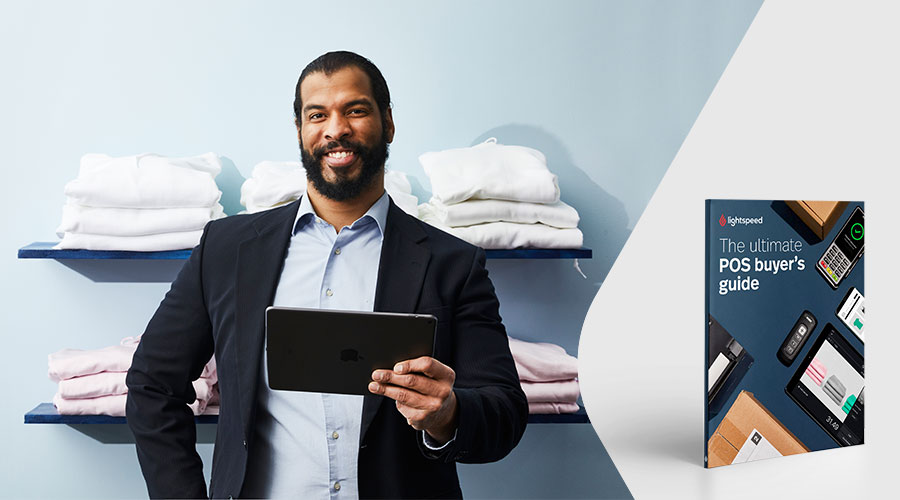
Whether you’re expanding locations and pursuing a more robust system or seeking to upgrade to a platform with deeper insights that can future-proof your position in the market, switching to a new POS system isn’t to be taken lightly.
Searching for a new POS system for your growing business can be a complicated process. How do you know what you need to ask? What features are absolutely necessary to help your business expand and thrive?
Having the right technology can be make-or-break for sales performance. We found that 68% of retailers said adopting new technology had a positive impact on their business.
Before you make a decision and risk investing in something that may not be what you need, do your research. We’re offering some advice on what to look out for when embarking on this hunt.
Make sure to ask these nine questions that outline what to look for in a POS system:
- How does the POS handle inventory?
- How does the POS system sync your online and retail store?
- Does the POS system empower your staff?
- Can you offer a personalized experience?
- Does the POS support your success?
- Does the POS system offer reporting and analytics?
- Does the POS system have embedded payments with a straightforward rate?
- Can the POS system enable you to run targeted marketing campaigns?
- Will the POS system support your business’ growth?
- What are the common questions to ask before choosing a POS?
The Ultimate POS Buyer's Guide
We’ll show you how to assess your current and future needs so you can ensure the system you choose can support your business now and in the future.

1. How does the POS handle inventory management?
As a retailer, your inventory is the heart of your business (along with your customer service). You need a system that can keep up. That means when you’re buying a POS, you should ensure the system has not only organizational tools but also built-in purchasing.
You should be able to handle complex inventory, such as serialized items and products with multiple different attributes—jeans that vary in color and size, for example. Beyond just that, you should be able to add custom tags to products so you can organize and manage items that may be grouped together thematically if not at the categorical level. Seasonal inventory, for example: you don’t want it cluttering up your POS when the season is over. Being able to tag inventory means it’ll be easier to find for archiving.
Don’t settle for inefficient purchasing workflows. Your new POS system should have purchasing tools built-in, like allowing you to create and receive purchase orders without leaving the point of sale back office. You should also be able to set reorder points—points at which a report will tell you that you need to order new stock before you have an empty shelf.
Lightspeed customer, Emily Linn, who owns and operates the Detroit-based City Bird along with her brother, likes the convenience and visibility of the stock control feature. As she describes it, “[It] has really revolutionized our buying. We used to use spreadsheets with complicated equations to see what we needed to reorder and it would take hours. And using that function, which auto generates amounts we need to reorder with, with numbers that you set, has allowed us to create pre-orders of products that are selling well and send them in minutes.”
What to look for in a POS system:
- Organizational tools like product matrices, customizable categories and tags
- An item import tool to get your stock set up quickly
- The ability to handle serialized inventory
- Native purchasing functions, like the ability to store vendor information, built-in purchase orders and reorder points
2. How does the POS system sync your online and retail store?
Imagine a store that never closes—that’s the power of running an omnichannel retail operation.
There’s little doubt that retailers selling both online and in-store bring in significantly more revenue than those who sell via one channel alone. In fact, in a recent survey Lightspeed conducted of retail businesses around the world, omnichannel retailers beat out single channel retailers for sales growth.
That’s why the right POS helps brick-and-mortar retailers build and strengthen online stores and sell through any channel. It’s not enough to have two disconnected systems. You need a commerce platform that will streamline selling online.
As Rachel Rosenthal co-owner of Myself Lingerie explains, “When we started talking about adding ecommerce to our business and firming up plans for the second location, we finally made the call. It was so easy to add the second store in Lightspeed, it was a no brainer. I haven’t looked back or regretted it once.”
What to look for in a POS system:
- Synchronization between the web and your physical stores when it comes to inventory, sales and order requests
- Consolidated reports on total sales, sales per physical store and sales from your eCommerce business
- The ability to extend your brand consistency between sales channels
3. Does the POS system empower your staff?
Customers have every resource at their disposal, from the internet to their friends and family. Often, before actually coming into a store, they have already conducted their research and are loaded up with questions to ask—ready to come in and get out. In fact, 81% of shoppers research their purchase online before coming into the store.
Retail employees need to feel as informed as the customers they work with, and smart mobile technologies are the way to accomplish that.
A good POS system shouldn’t eat up employees’ time or make them want to pull their hair out. It should offer them the information they need, immediately, so they can serve customers and move people through the store. They’re the ambassadors of your brand; don’t leave them out of the equation when you consider your store’s technology.
Hallie Rae Ward, Business Director at boutique gallery Art for the People, sought a system that would make things seamless for staff and artists alike, maintaining a flow of information so all parties are informed. As Ward describes it, “Lightspeed makes it easy for our staff to talk to and sell what’s on the floor, our management team to know what’s in inventory and our artists to know what they’re owed. It helps us run smoothly on the gallery floor and in the back office.”
What to look for in a POS system:
- Secure logins for every employee
- Dashboards that can be customized for every employee
- Intuitive interface that minimizes training time
- The capacity to fill out detailed inventory entries, including photos
- Easy-to-use tools that employees feel comfortable using
4. Can you offer a personalized experience?
Building off of the last question, you’ll want to make sure the new POS system offers your customers as good an experience as it can offer your staff.
The system should store customer profiles, including purchase histories so your employees can make tailored product recommendations. With those customer profiles in hand, it doesn’t matter who is on shift or how senior a sales associate is. Every customer who walks in the door can feel like a regular, encouraging loyalty.
Before you buy a POS system, make sure it has built-in loyalty tools, with the option to add deeper tools as needed. At the very least, you should be able to set up the ability to earn financial incentives through purchases—loyalty dollars for money spent—to encourage repeat visits.
Tori Erikson founder of Loyal Tee takes full advantage of the deep knowledge of his customer’s buying habits to strengthen the connection with clientele and sees the benefit for both sides. Erikson explains, “Lightspeed’s Omnichannel loyalty is awesome. Customers can earn points no matter how they shop and use those points to get fun gifts. Plus, it helps me know what they like, build a relationship and personalize my service.”
What to look for in a POS system:
- Built-in customer profiles that store purchase histories
- The ability to use the POS on an iPad so employees can serve customers anywhere in the store
- Loyalty integrations that let you make the most of your customer data
5. Does the POS support your success?
People are different. Retailers are different. The principles may be the same, but each store and employees have differences and come with their own preferred workflows, challenges, preferences, requirements and goals.
When you’re buying a POS system, a good vendor helps you figure out if the software fits your needs (if it will help your store succeed) and will help you with onboarding sessions as well as offer technical support for those times when something just doesn’t make sense. You shouldn’t be left alone as soon as the purchase is made, so always make sure to ask about what kind of post-sales support your vendor offers.
Richard Shane, co-owner of Rocket Fizz, knows the challenges that come with opening a new location and counts on Lightspeed for efficient launches, time saving and support throughout. Shane explains, “It used to take five days to set up a POS at a new location. Now it takes three or four. That 20-40% of time saved is a massive improvement.”
What to look for in a POS system:
- Multiple ways to reach the support team, such as over the phone, online tickets and live chat
- Local channel partners—specialists who provide on-site consultation, installation and troubleshooting services
- Variety of training materials, including online help and product information, courses, videos or webinars
- Published customer satisfaction ratings and online product reviews
- Onboarding sessions for managers and employees
- An online social media presence for communicating more closely with the organization
6. Does the POS system offer reporting and analytics?
With legacy systems, retailers didn’t always have an accurate picture of their business. Goods came and went, but business managers had only a vague idea of profits and performance. Times have changed.
In today’s highly competitive environment, retailers can’t afford to take risks. Many have turned to using data to make business decisions, but only 16% say they’re experts at using that data.
That’s why a good POS will show you how well you’re doing and where you can improve to capitalize on new opportunities and pivot when the retail winds change. You should be able to dive deep into the data your POS is processing every day to pinpoint best sellers and overall sales performance at the very least.
Limbo Jewelry thrives using Lightspeed Reporting data to drill down to what is working. Owner Anne Rutt-Enriquez says the feedback from suppliers,”They say we’re the most organized store they work with because we’re able to pinpoint exactly what’s selling, exactly what’s not selling.”
What to look for in a POS system:
- Reports that show your most profitable products, top-selling products, lowest selling products, top-performing sales associates, busiest store hours, top brands and online vs. in-store sales
- Dashboards highlighting the information you need
- Easy access to information for better decision-making, such as for inventory purchasing and staff scheduling
With Lightspeed Advanced Reporting options you can customize your home dashboard. And you can add additional metrics for you and your team including average sale value, discounts or top products sold under Things to know. This allows your store managers to quickly see the most important metrics throughout the day and make informed decisions.
7. Does the POS have embedded payments with a straightforward rate?
You could have the most advanced inventory management system in the world—and the best possible customer loyalty tools—but if you’re overpaying for your payments, or worse, if they’re inefficient and unintegrated, your POS system isn’t doing enough for you.
Embedded payments, like Lightspeed Payments, reduce the possibility for human error, because the amount to pay is automatically pushed to your payment terminal. That also reduces the amount of time spent at checkout, and cuts the amount of receipt paper you need in half.
You’ll want those embedded payments to have a straightforward fee scheme as well, so you always know what you’re paying. Interchange plus rates can be murky and confusing, as you don’t always know what fee a particular customer’s card will have. With a flat fee structure, you know exactly what to budget for.
Finally, when your payment processor and your POS system have been developed by the same company, you’ll never need to bounce between companies if you ever have a question.
What to look for in a POS system:
- Embedded payments that save you time
- Reports on your payment data from your POS
- An easy-to-predict fee structure
- A 24/7 support team that is knowledgeable about your payments and your POS both
8. Can the POS system enable you to run targeted marketing campaigns?
It’s a generally accepted fact that existing customers are more valuable—and more likely to make a purchase—than new customers. As a result, today’s leading marketers are no longer sending out generic email blasts to everyone who has ever interacted with a company. They’re crafting consumer conversations and pinpointing what their customers actually want to know about.
Buying the right POS system helps improve relationships with your shoppers and send relevant communications tailored to your customers’ preferences.
You’ll want to be able to integrate with loyalty tools that can use the customer data you have in your new POS system to send out tailored promotions, like birthday rewards.
What to look for in a POS system:
- Customer database for capturing name, contact info, the preferred method of contact, favorite brands, walk-in or online shopper
- Integrates with email marketing software for emailing customers and tracking click-through rates
- Features for segmenting your customer database, and tailoring promotions to fit those segments
9. Will the POS system support your business’ growth?
When it comes to buying a POS system, think about the long-term costs and what you may need in the future.
While it can be tempting to go for the cheapest and simplest system when you’re getting started, you’ll regret it when you outgrow it in a year’s time. Retailers need scalable systems that can grow as their business does.
Basically, if you don’t budget for a POS equipped for long term success now, you’ll pay in time and money down the line when you need to switch.
Rabee Ikkawi, co-owner of the Kids Atelier, knows it’s not just what’s happening in the moment but the resources at your fingertips as you grow your business. And with over 9 locations, Ikkawi knows it begins at store level:
“What I like about Lightspeed is that it offers the simplicity an average cashier would like to see. And in the backend you have enterprise depth to the data.”
What to look for in a POS system:
- Registers that you can add as you need, whether it’s for a permanent new location or for a pop-up shop
- Support for multiple locations, integrating inventory reporting
- Integration with common and useful software, such as MailChimp, Google Analytics and QuickBooks
- Open technology so independent developers can easily develop apps that you can add to your POS
10. What are the common questions when choosing a POS?
How do I choose a POS?
Choosing a point of sale system is a critical step in any business. There are a variety of considerations when it comes to selecting a POS that is right for your business including:
- Your business and industry needs
- Range of features and functionality
- Ease of use
- Compatibility
- Ease of integration
- Scalability
- Hardware requirements
- Payment processing
- Security
- Customer support and training
- Costs & pricing structure
- Reviews & recommendations
- Offline capabilities
- Customization
- Updates and maintenance
What makes a good POS?
In selecting the right POS (point of sale) for your business you want something the optimizes efficiency for your business needs and provides a more valuable experience to both staff and customers. When doing your research you should look at a variety of characteristics like a user-friendly interface, efficient transaction processing, inventory management, integration and customization options, offline capabilities, reporting and payment processing options.
Can you run a POS system without the internet?
Yes it is possible to run a POS without the internet. Some point of sale systems are designed to work offline to provide business owners flexibility and continued smooth operations even in the absence of the internet. Systems that allow this typically have an offline mode and local data storage for transactions. Verify that the POS system has security measures in place to protect data during offline transactions and come up with a set of back-up procedures.
Buy a POS system that fits your store’s needs
As you implement a new POS system inside your retail store (or multiple stores), you need to make sure that it’s something you won’t need to update in a month. A business management tool that helps you move online and add locations as you need is a tool that you’ll be happy training your staff on and be able to use for a long while moving forward.
Lightspeed might be that tool for you. With advanced inventory management, built-in purchasing and CRM tools, an intuitive system for your employees and more, we just might have what your business needs to thrive.

News you care about. Tips you can use.
Everything your business needs to grow, delivered straight to your inbox.



